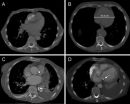(Press-News.org) An international research team led by Academy Professor Kari Rissanen of the University of Jyväskylä (Finland) and Professor Rainer Herges of the University of Kiel (Germany) has managed to make a triple-Möbius annulene, the most twisted fully conjugated molecule to date, as reported in Nature Chemistry (DOI:10.1038/nchem.1955, published online 25 May 2014).
An everyday analogue of a single twisted Möbius molecule is a Möbius strip. It can be made easily by twisting one end of a paper strip by 180 degrees and then joining the two ends. A triple twisted Möbius molecule is more difficult to visualize, but its graphical representation resembles the well-known recycling logo, this time with three twisted corners.
However, it has turned out to be extremely difficult to twist molecules to a Möbius surface that has only one side. Up to now, only the simplest Möbius molecules have been prepared. Now Dr. Gaston Schaller and Professor Rainer Herges from the University of Kiel and M.Sc. Filip Topić and Academy Professor Kari Rissanen from the University of Jyväskylä, together with Professor Yoshio Okamoto (Osaka, Japan) and Jun Shen (Harbin, China), have succeeded in preparing and characterizing a triple twisted annulene – a more complex Möbius molecule which has three twists but only one surface. Currently these chiral one-sided compounds are merely scientifically intriguing topological objects and far from practical application, but they exhibit a high potential in future applications in molecular electronics and optoelectronics.
INFORMATION:
Further information:
An article about the research was published in Nature Chemistry: http://dx.doi.org/10.1038/nchem.1955
Academy Professor Kari Rissanen, University of Jyväskylä, tel. +358 50 5623 721, kari.t.rissanen@jyu.fi
Professor Rainer Herges, University of Kiel, tel. +49 431 880 2440, rherges@oc.uni-kiel.de
Molecules do the triple twist
2014-05-27
ELSE PRESS RELEASES FROM THIS DATE:
Insights into genetics of cleft lip
2014-05-27
Scientists at the European Molecular Biology Laboratory (EMBL) in Heidelberg, have identified how a specific stretch of DNA controls far-off genes to influence the formation of the face. The study, published today in Nature Genetics, helps understand the genetic causes of cleft lip and cleft palate, which are among the most common congenital malformations in humans.
"This genomic region ultimately controls genes which determine how to build a face and genes which produce the basic materials needed to execute this plan", says François Spitz from EMBL, who led the work. ...
Clinical trial reaffirms diet beverages play positive role in weight loss
2014-05-27
May 27, 2014 – A groundbreaking new study published today in Obesity, the journal of The Obesity Society, confirms definitively that drinking diet beverages helps people lose weight.
"This study clearly demonstrates that diet beverages can in fact help people lose weight, directly countering myths in recent years that suggest the opposite effect – weight gain," said James O. Hill, Ph.D., executive director of the University of Colorado Anschutz Health and Wellness Center and a co-author of the study. "In fact, those who drank diet beverages lost more weight and reported ...
Heavily decorated classrooms disrupt attention and learning in young children
2014-05-27
VIDEO:
Maps, number lines, shapes, artwork and other materials tend to cover elementary classroom walls. However, new research from Carnegie Mellon University shows that too much of a good thing may...
Click here for more information.
PITTSBURGH—Maps, number lines, shapes, artwork and other materials tend to cover elementary classroom walls. However, new research from Carnegie Mellon University shows that too much of a good thing may end up disrupting attention and learning in ...
Migrating stem cells possible new focus for stroke treatment
2014-05-27
Two years ago, a new type of stem cell was discovered in the brain that has the capacity to form new cells. The same research group at Lund University in Sweden has now revealed that these stem cells, which are located in the outer blood vessel wall, appear to be involved in the brain reaction following a stroke.
The findings show that the cells, known as pericytes, drop out from the blood vessel, proliferate and migrate to the damaged brain area where they are converted into microglia cells, the brain's inflammatory cells.
Pericytes are known to contribute to tissue ...
Health issues, relationship changes trigger economic spirals for low-income rural families
2014-05-27
When it comes to the factors that can send low-income rural families into a downward spiral, health issues and relationship changes appear to be major trigger events. Fortunately, support networks – in particular, extended families – can help ease these poverty spells, according to new research from the NH Agricultural Experiment Station at the University of New Hampshire College of Life Sciences and Agriculture.
The research was conducted by Elizabeth Dolan, emeritus associate professor of family studies at UNH, and her colleagues Sheila Mammen at the University of ...
Africa's longest-known terrestrial wildlife migration discovered
2014-05-27
WASHINGTON, DC - Researchers have documented the longest-known terrestrial migration of wildlife in Africa – up to several thousand zebra covering a distance of 500km (more than 300 miles) – according to World Wildlife Fund (WWF).
Using GPS collars on eight adult Plains zebra (Equus quagga), WWF and Namibia's Ministry of Environment and Tourism (MET), in collaboration with Elephants Without Borders (EWB) and Botswana's Department of Wildlife and National Parks, tracked two consecutive years of movement back and forth between the Chobe River in Namibia and Botswana's Nxai ...
Chest CT helps predict cardiovascular disease risk
2014-05-27
OAK BROOK, Ill. – Incidental chest computed tomography (CT) findings can help identify individuals at risk for future heart attacks and other cardiovascular events, according to a new study published online in the journal Radiology.
"In addition to diagnostic purposes, chest CT can be used for the prediction of cardiovascular disease," said Pushpa M. Jairam, M.D., Ph.D., from the University Medical Center Utrecht, in Utrecht, the Netherlands. "With this study, we have taken a new perspective by providing a different approach for cardiovascular disease risk prediction ...
An area's level of poverty or wealth may affect the distribution of cancer types
2014-05-27
A new analysis has found that certain cancers are more concentrated in areas with high poverty, while other cancers arise more often in wealthy regions. Also, areas with higher poverty had lower cancer incidence and higher mortality than areas with lower poverty. Published early online in CANCER, a peer-reviewed journal of the American Cancer Society, the study's findings demonstrate the importance of including measures of socioeconomic status in national cancer surveillance efforts.
Overall, socioeconomic status is not related to cancer risk—cancer strikes the rich and ...
E-cigarettes: Not a healthy alternative to smoking
2014-05-27
ARLINGTON HEIGHTS, Ill. (May 27, 2014) – Caveat emptor – or "buyer beware" holds true when it comes to the unknown health effects of e-cigarettes. An article in the June issue of Annals of Allergy, Asthma & Immunology, the scientific journal of the American College of Allergy, Asthma and Immunology (ACAAI), examines risks, including the ongoing dependence on nicotine and the dual use of e-cigarettes and regular cigarettes.
The article examines the idea that one of the initial "health benefits" proposed by e-cigarettes makers was that it would help those who smoke cigarettes ...
Annals of Internal Medicine tip sheet for May 27, 2014
2014-05-27
1. Task Force: Screen high-risk individuals for hepatitis B
The U.S. Preventive Services Task Force (USPSTF) recommends hepatitis B virus (HBV) screening for nonpregnant high-risk adolescents and adults, according to a recommendation statement being published in Annals of Internal Medicine. Up to 2.2 million people in the United States have chronic HBV, and 15 to 25 percent of those infected will die from liver disease or liver cancer. Screening for HBV could identify those who may benefit from treatment. Most people born in the United States have been vaccinated for ...


